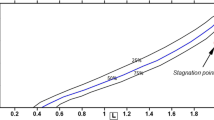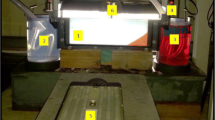Abstract
Transport of contaminants in aquifers has received considerable attention over the past few years. In coastal aquifers, a dispersion zone between saline water and fresh water exists where the flow of water and transport of salt ions are coupled. The flow pattern of two miscible fluids of different unit weights is characterized by the cyclic flow at the shore boundary. The width of the dispersion zone may be considerable, with the sharp interface assumption leading to erroneous results. A finite element model was applied to two prepublished problems for purposes of obtaining a better understanding of the saline water intrusion phenomenon. The effect of lowering the piezometric head due to excessive pumping was investigated. Physical parameters were extracted from the studies conducted by Kawatani and Rouve and Stoessinger, and comparison with their results was made.
Resumé
Pendant les dernières quelques années, le transport des contaminants dans les aquifères a reçu une attention considerable. Aux aquifères de la côte, il existe des zones où l'eau salé et l'eau douce se dispersent quand le flux de l'eau et le transport des ions du sel s'unissent. Le patron de flux [flow pattern] des fluides miscibles qui ont des différents unités de poids est characterisé par le flux cyclique au bord de la côte la largeur de la region de dispersion est considerable, et les suppositions de ‘'interface tranchante’ [sharp interface] peut conduire a des faux résultats. Pour mieux comprendre le phénomène de l'instrusion de l'eau salé, le modèle des ‘éléments limités’ [finite element] a été appliqué dans deux problèmes dejà publiés. L'effet de l'abaissement piezométrique à cause du pompage excessif a été étudiés. Les paramètres physique ont été extraits des cas dejà étudiés, conduits par Rouven-Stoessinger et Kawatani, et la comparaisons avec leurs résultats a été fait.
Similar content being viewed by others
References
Anand, S. G. and Pandit, A., 1982, Finite element solution for coupled groundwater flow and transport equations and transient conditions including the effect of the selected time step size, Proc. 4th Internat. Conf. Finite Elements in Water Resources, University of Hannover, Hannover, Germany.
Bear, J., 1979, Hydraulics of Groundwater, McGraw-Hill, New York.
Grove, D. B., 1977, The use of Galerkin finite-element methods to solve mass-transport equations, U.S. Geol. Survey Water Resources Investigations, 77–49.
Heinrich, J. C., Huyakorn, P. S., Mitchell, A. R., and Zienkiewicz, O. C., 1977, An upwind finite element scheme for two-dimensional convective transport equation, Internat. J. Numer. Methods Engrg. 11.
Henry, H. R., 1964, Effect of dispersion on salt encroachment in Coastal aquifers, U.S. Geological Survey Water Supply Paper 1613-C.
Huyakorn, P. S. and Pinder, G. F., 1983, Computational Methods in Subsurflace Flow, Academic Press, New York.
Huyakorn, P. S. and Taylor, C., 1976, Finite element model for coupled groundwater flow and convective dispersion, Proc. 1st Internat. Conf. Finite Elements in Water Resources, Princeton, New Jersey.
Katapodes, N. D., 1984, A dissipative Galerkin scheme for open-channel flow, J. Hydraul. Engrg. 110, 450–466.
Kawatani, T., 1980, Behavior of seawater intrusion in layered coastal aquifers, Proc. 3rd Internat. Conf. Finite Element in Water Resources, Univ. of Miss., Oxford, Miss.
Meissner, U., 1973, Die Berechnung ebener und Raumlicher Grund-u Sickerwassrstromungen mit verallgemeinerten variationsverfahren, Mitt. des SFB 79 f. Wasserforschung im Kustenbereich der TU Hannover, H.2.
Pandit, A. and Anand, S. G., 1984, Groundwater flow and mass transport by finite elements — a parametric study, Proc. 5th Internat. Conf. Finite Elements in Water Resources, University of Vermont.
Pinder, G. F., 1973, A Galerkin-finite element simulation of groundwater contamination on Long Island, Water Resour. Res. 9(6), 1657–1669.
Pinder, G. F. and Cooper, H. H., 1970, A numerical technique for calculating the transient position of the saltwater front, Water Resour. Res. 6(3), 875–882.
Rouve, G. and Stoessinger, W., 1980, Simulation of the transient position of the saltwater intrusion in the coastal aquifer near Madras coast, Proc. 3rd Internat. Conf. Finite Elements in Water Resources, Univ. of Miss., Oxford, Miss.
Sa da Costa, A. A. G. and Wilson, J. L., 1979, Numerical model of seawater intrusion in aquifers, MIT Report 247, Massachusetts Institute of Technology, Cambridge, Mass.
Segol, G. and Pinder, G. F., 1976, Transient simulation of waltwater intrusion in southeastern Florida, Water Resour. Res. 12(1), 65–70.
Sherif, M. M., 1987, A Two-Dimensional Finite Element Model for Dispersion (2D-FED) in Coastal Aquifers, PhD thesis, Faculty of Engineering, Caïro University.
Stoessinger, W., 1979, Beschreibung der hydrodynamischen Dispersion mit der Methode der finiten Elemente am Beispiel der instationaren Interface zwischen Sub-und Salzwasser in Grundwasserleitern, Institut für Wasserbau und Wasserwirtschaft, Rheinisch-Westfalische Technische Hochschule Aachen, 28.
Author information
Authors and Affiliations
Rights and permissions
About this article
Cite this article
Mohsen, M.S., Singh, V.P. & Amer, A.M. A note on saltwater intrusion in coastal aquifers. Water Resour Manage 4, 123–134 (1990). https://doi.org/10.1007/BF00429801
Received:
Revised:
Issue Date:
DOI: https://doi.org/10.1007/BF00429801




